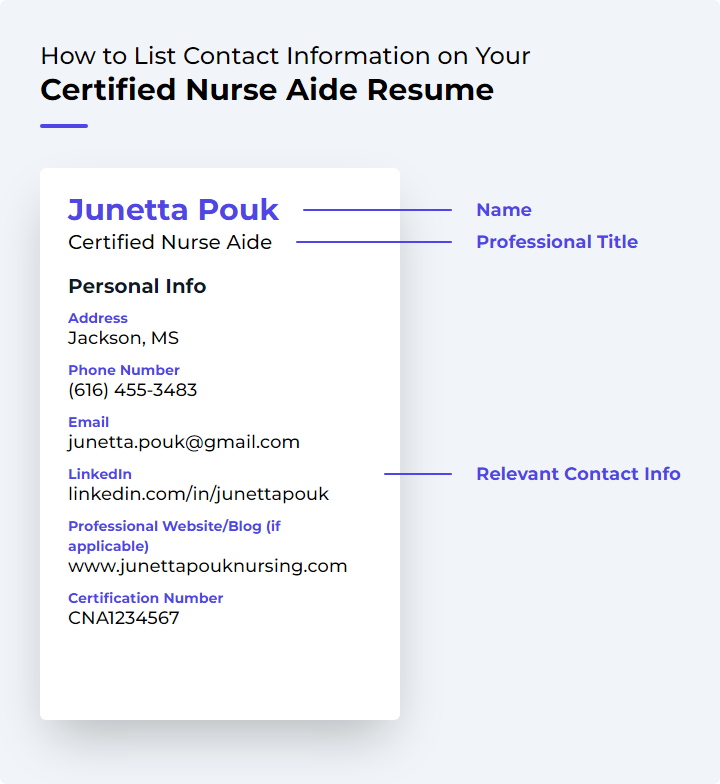Certified Nurse Aide Resume Examples
Writing a great certified nurse aide resume is important because it is one of the first things a potential employer will see when they are considering you for a position. It is your opportunity to make a good first impression and sell yourself as the best candidate for the job.
Create your resume
Select from 7 professional resume templates
If you're looking for inspiration when it comes to drafting your own certified nurse aide resume, look no further than the samples below. These resumes will help you highlight your experience and qualifications in the most effective way possible, giving you the best chance of landing the certified nurse aide job you're after.
Essential Components of a Certified Nurse Aide Resume
A Certified Nurse Aide (CNA) resume serves as a professional blueprint, showcasing your nursing skills, experience, and education. It's a tool to market your qualifications for a targeted role. A well-crafted CNA resume should highlight your expertise, abilities, and dedication to patient care. This article will break down the essential sections of a CNA resume, explain their significance, and provide guidance on how to optimize them to attract potential employers.
1. Contact Information
Your contact information is vital and should be prominently placed at the top of your resume. Include your full name, phone number, professional email, and your city and state. Ensure your name is in bold and a larger font to stand out.

Consider adding a LinkedIn profile or other professional networking links, ensuring they are up-to-date and portray you professionally. While some opt to include their full address, listing just your city and state can suffice and help protect your privacy.
Accuracy and currency of your contact details are crucial for employers to reach you with ease.
2. Professional Summary or Objective Statement
The Professional Summary or Objective Statement introduces you to potential employers, summarizing your skills, experience, and career aspirations. Keep it concise, no more than three sentences, and tailor it to the job you're applying for.
Experienced CNAs should use a professional summary to highlight achievements and skills relevant to the job. Conversely, newcomers or career changers may benefit from an objective statement that focuses on transferable skills and enthusiasm for the nursing field.
Customize this section for each job application to align with the employer's requirements as outlined in the job posting.
3. Licenses and Certifications
The Licenses and Certifications section is critical, distinguishing you as a qualified professional. List your CNA license, including the issuing organization and expiration date, followed by any additional healthcare certifications like BLS, ACLS, or PALS. Highlight any specialized training, such as dementia care or wound management, to showcase your breadth of knowledge.
Keep this section updated with any new credentials to reflect your current qualifications.
4. Relevant Skills and Competencies
The Key Skills and Abilities section should spotlight your unique competencies that make you an ideal candidate. Include clinical skills, communication abilities, patient care experience, emergency response training, attention to detail, physical stamina, empathy, time management, medical terminology knowledge, and teamwork skills. Provide examples to demonstrate how you've effectively applied these skills in practice.
5. Work Experience in Healthcare Settings
The "Healthcare Work History" section delves into your practical experience in the field. List your relevant positions, starting with the most recent, and detail your responsibilities and achievements. Use action verbs and quantify your experiences where possible. Don't hesitate to include significant internships or volunteer work if they are relevant to healthcare.
6. Education and Training
In the Education and Training section, outline your educational background, starting with your high school diploma or GED. Detail your CNA certification, any additional healthcare certifications, continuing education courses, clinical experience, and specific skills training. Present this information in a clear, chronological format.
7. References or Recommendations
References or endorsements can validate your professional capabilities. Include contacts who can attest to your work as a CNA, such as former supervisors or instructors. Always ask for permission before listing someone as a reference and provide their full name, title, organization, phone number, and email address. A brief description of your relationship with the reference can be helpful.
While references are important, they should complement rather than replace the detailed information about your qualifications and experience presented in other sections of your resume.
[Include any additional related links or images as needed, ensuring they fit organically within the content and provide value to the reader.]